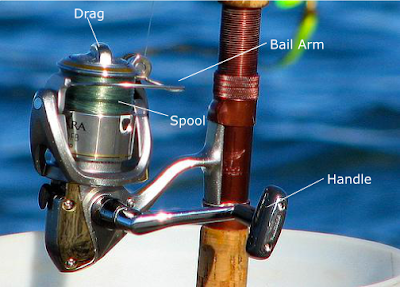 |
| Fly Rod and Spinning Rod |
Fishing rods and reels have come a long way from being a line tied to a stick. They vary widely and an angler can find the ideal rod/reel combo for whatever kind of fishing they're looking to do. However, this availability of so many options can be overwhelming to someone new to fishing and there is no one rod/reel combination that is perfect for everything. Here is some basic info that'she helpful to know to get started as well as some rod and reel combinations that are great for someone just learning how to fish and will be effective in fishing for a wide range of fish.
Kinds of Rods & Reels
Spinning Rod & Reel
*RECOMMENDED FOR BEGINNERS*
Spinning rods and reels are the ideal choice if you need to be able to cast the line in order to get your hook where the fish may be, as opposed to just dropping it straight down or a few feet in front of you. They're also the easiest type of reel to learn and master casting with. This makes them ideal for someone new to fishing. Spinning equipment can be used with both, live bait or lures. |
| Anatomy of the Spinning Reel CC Image courtesy of Jan Tik on Flickr |
- Spool: the part of the reel which fishing line is wound around
- Bail Arm: the device that allows the release of the line or keeping the line in place on the spool
- Drag: the knob which tightens or loosens the spool. Either makes it easier or more difficult for line to come out while fighting a fish
- Handle: the part of the reel which you turn in order to retrieve the line
Conventional Rod & Reel
Anatomy of the Fishing Rod
- Butt: The bottom half or third of the rod
- Ferrule: The joint where the rod can be separated into two pieces
- Grip: The handle part that you hold onto
- Guides: Circular rings attached to the rod that direct line from the reel to the tip of the rod. Spinning rod guides tend to get progressively smaller as you go from reel to tip
- Reel Seat: The part of the rod which secures the reel to the rod, usually by the tightening of washers or rings over the base of the reel
Rod Specifications
- Action: this defines how fast and where a rod bends. Rods can be ultrafast, fast, moderate, and slow. Rods with slow action have the most bend while a rod with ultrafast action will have the least bend.
- Recommendation: The best rods for beginners would have moderate action since it can be used for a wide variety of fish ranging from bluegills to bass
- Note: Some rod manufacturers may replace the term "slow" with "soft"
- Power: This is basically the weight that the rod can withstand. Rods are classified under Ultra-Light, Medium-Light, Medium, Medium-Heavy, or Ultra-Heavy. Ultra-light rods are best for small fish and Ultra-Heavy rods are used in deep sea fishing and surf fishing.
- Recommendation: A Medium-Light to Medium weight rod is the ideal weight for the beginner. It's very versatile and is great for a wide range of fishing. You can't go wrong, however, asking a salesperson at your local fishing tackle retailer to see what weight is best for your specific needs.
- Length: obviously, we know what this means. It is expressed in feet and inches. The longer the length, the longer the cast.
- Recommendation: Should be short enough to control but long enough to get decent casting distance (8-9ft. for adults--shorter for children)
- Optimum Lure/Line Weight: this designation, usually displayed in ounces or grams, identifies the range of how much weight the rod can optimally cast.
- Ex.- "1-4 oz." means the rod works well casting weights between 1 and 4 ounces
- Ex.- "Line 4-8 lb." indicates that the ideal line weight is from 4 to 8 pounds
- Rod Composition: rods can be made of a wide variety of materials and each has an effect on the feel of the rod during use. The following are the materials being used in the majority of modern rod construction...
- Graphite: Rods are lightweight and sensitive to activity on the bait but are also more fragile and is prone to breaking if under significant stress
- Fiberglass: Strong and durable rods but they're heavier than graphite and more cumbersome as a result
- Composite: These rods are a combination of both, fiberglass and graphite. As a result, they are lightweight, durable, and sensitive to fish activity
TIP: I typically enjoy using equipment that's lightweight relative to the fish that I'm going for because it allows even the smaller fish to put up a decent fight. It makes the fishing fun...which is exactly what it should be! You don't want to be yanking trout out of the water with a Tuna rod
No comments:
Post a Comment